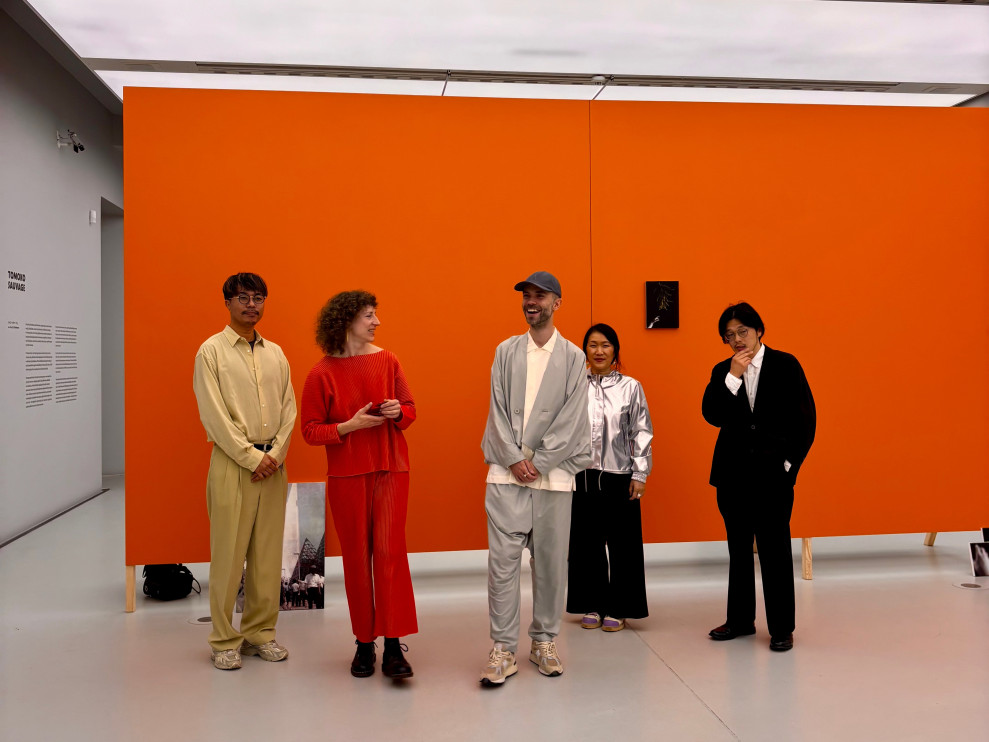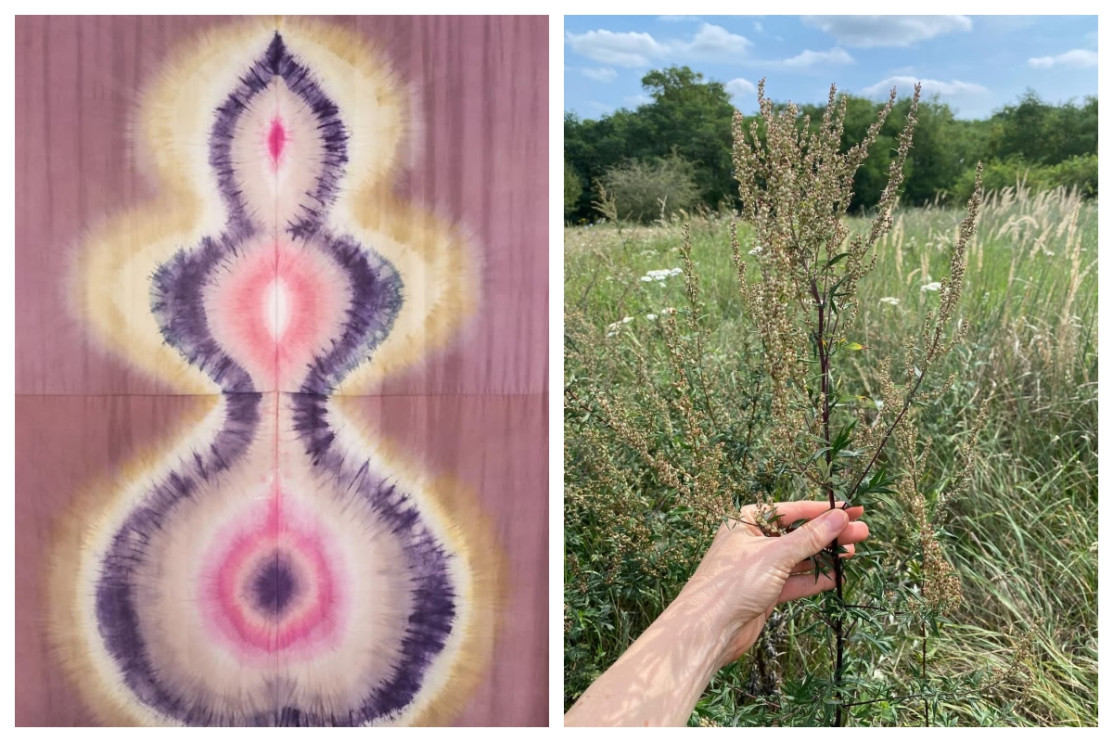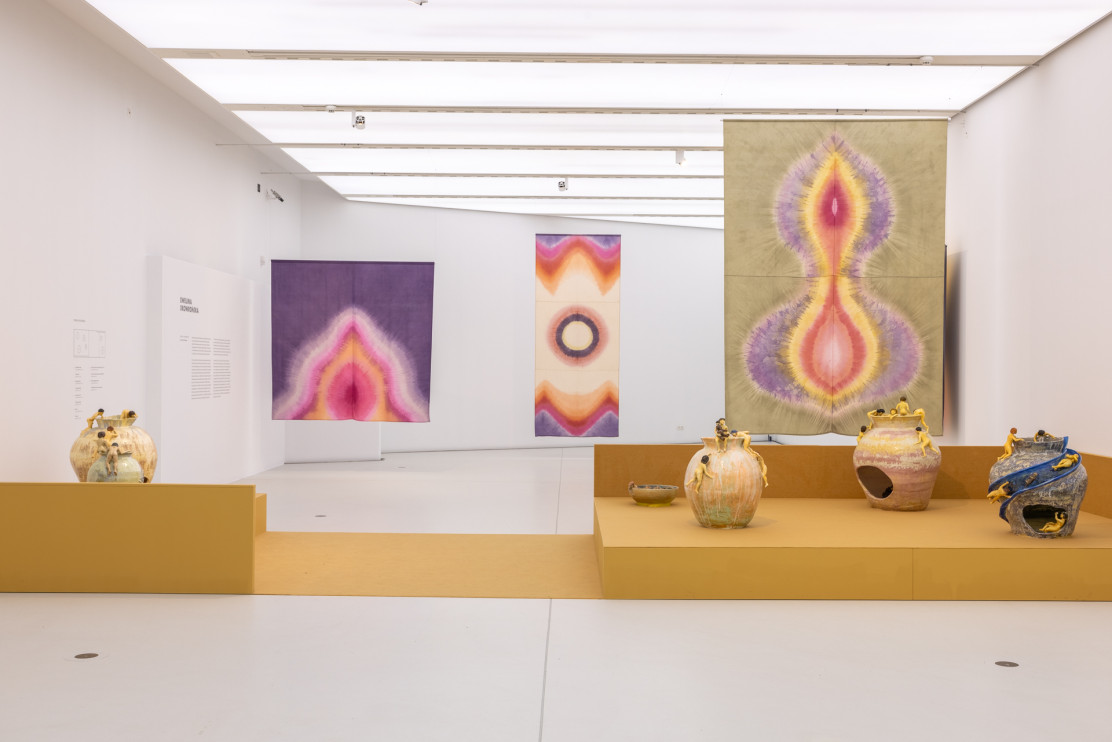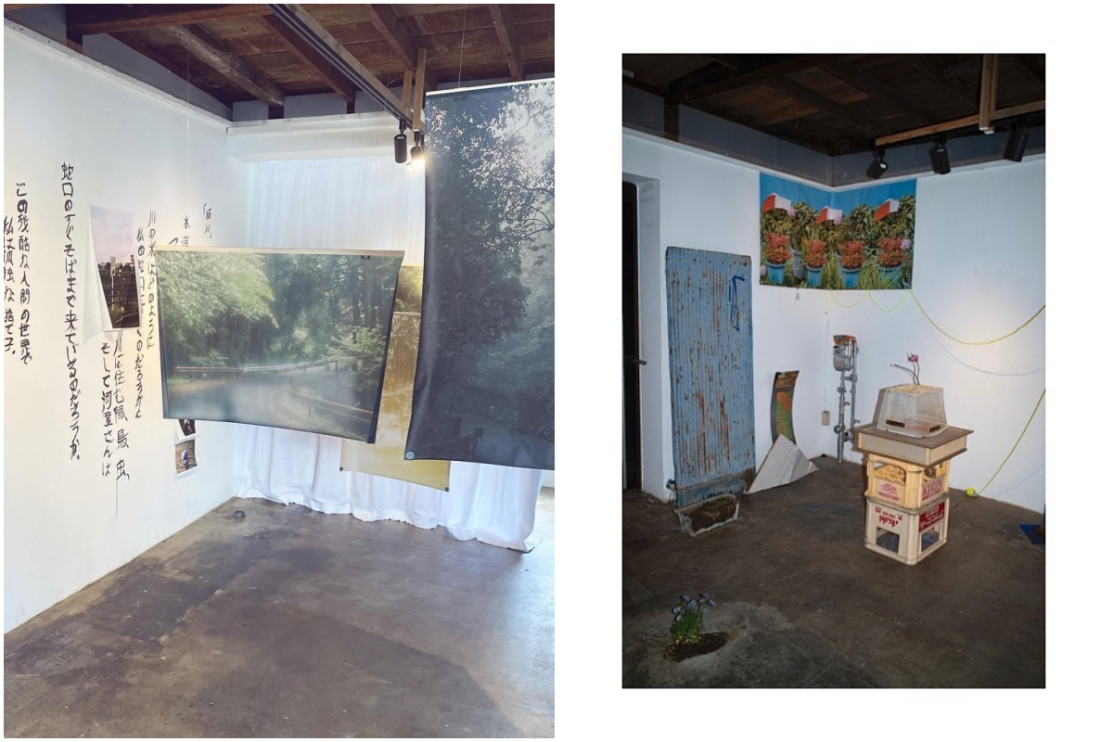WELL ART - Ewelina Skowrońska: "I immerse fabrics in plants as if in prayer"

East–East is not another attempt to mythologize the East and portray it as an exotic counterpoint to the West. Instead of perpetuating stereotypes, curator Paweł Pachciarek constructs a narrative of Japan through the prism of the personal stories of artists whose lives, albeit in different ways, are intertwined with this country. Their experiences of migration, redefining identity, and re-rooting create a multi-voiced narrative about being between cultural, geographic, and linguistic poles.
Among the co-creators of works in the East–East exhibition is Ewelina Skowrońska, a visual artist returning to the Polish art scene after a decade living and working in Japan. Her hand-dyed textiles take the form of contemporary totems, plant landscapes on silk, conveying a message of spiritual connection. Through organic compositions, she speaks to the need to return to simple practices rooted in nature.
 Artists co-creating the East–East exhibition | photo: Well.pl
Artists co-creating the East–East exhibition | photo: Well.plJust before the closing ceremony, we talk to the artist about the role of traditional techniques in building contemporary sensibilities, the influence of Japanese aesthetics on her creative practice, and how art can be an attempt to organize reality, both personal and collective.
A Polish artist after a decade living in Japan. How did the East change her perspective on art and life?Maria Jasek, Well.pl: "East–East" is the second exhibition at the Manggha Museum showcasing your work. This time, you're the only artist from Poland. What new things do you bring to the table, formally, emotionally, and thematically?
Ewelina Skowrońska: My previous exhibition at the Manggha Museum was part of a project initiated in Japan, which I produced together with Monika Brauntsch, also active in The Spirit of Poland Foundation. It was an exhibition titled "Inner Strength – The Women of Poland and Japan," dedicated to women from two different cultures. We wanted to explore their experiences, needs, and what unites and differentiates them. We invited five artists from Japan and five from Poland to participate, and the exhibition focused primarily on illustration and graphic design.
Besides the fact that East-East differs from the previous project in terms of content, it is the first major presentation of my work since returning to Poland, and the first one so clearly set in a Polish context. I'm delighted that my work is being shown as part of a broader discussion about East-West relations, with references to Japan but also with a strong Polish accent.
 Fabric and dye plant | Photo: Instagram @ewellelo
Fabric and dye plant | Photo: Instagram @ewelleloYou moved to Japan 10 years ago and stayed there for a while. Was that the plan?
Years earlier, during my first visit to Japan, I'd briefly entertained the thought: "I could live here someday." And indeed, a few years later, that dream came true, although it was my partner's job that dictated it. It's a bit of a "be careful what you wish for, it might come true" kind of story.
This was after your art studies, so from an academic perspective, you were already a mature artist. How did this cultural shift impact your work? Did it develop it, or rather give it a completely different direction?
From an academic perspective, yes, but today I feel like my artistic maturation began in Japan. I don't want to idealize and say that that culture changed me. I believe that every environment influences a person—whether it's London, Poland, Japan, or South America. I try to approach these kinds of questions with caution, because it's not like I "gained" anything. It was, without a doubt, an important stage.
My long stay in a foreign culture, initially without any chance of communication because the Japanese spoke little English, became an experience of silence in which I heard myself. I realized then that I was from Europe, from Poland, that where I came from mattered. That the moment I was born also shaped me. Thanks to this cultural and emotional opposition, I was able to look deeper.
In addition, I've become more sensitive to things that are less appreciated in Europe. Craftsmanship, handiwork, patience, attention to detail – there, it's a pleasure, treated as a form of artistry, and the process is as important as the end result. I've also paid more attention to nature, not in an idealized way, but as something we are a part of.
Natural Dyes, Silk, and Plants: Ewelina Skowrońska's Art as a Spiritual PracticeWe're standing here in front of fabrics you've dyed using natural plant dyes. In your work, nature not only carries meaning but also becomes a tool you consciously use to achieve a specific visual effect. What's most important when interpreting East-East works?
The sheets are made of silk, and most of the dyes are from plants I collected myself. I was inspired by the idea of talismans and totems—objects that people have looked to for protection, support, good harvests, or safety for centuries. I wanted to create contemporary versions that address the challenges of the modern world.
Each color on the fabric is based on carefully selected plants known for their use in herbalism and spiritual practices. These are my own compositions, potions that, according to tradition, carry specific energy and meaning.
In a world filled with uncertainty, change, and a sense of loss, we especially need places of solace today. Spaces that allow us to encounter the invisible, intuitive, and difficult to rationalize, yet deeply felt. A textile entitled "Hope" is an example, as it is something we especially need today. Another work addresses the concept of fertility, understood not only literally but also as creative potential, the ability to initiate something new. This is the energy necessary to transcend established patterns and open ourselves to change and the creation of new ways of thinking.
 “Dreaming of Remedy”, Ewelina Skowronska’s textiles at the East–East exhibition | photo: Manggha Museum press materials
“Dreaming of Remedy”, Ewelina Skowronska’s textiles at the East–East exhibition | photo: Manggha Museum press materialsIsn't this a time-consuming process?
Yes. I use traditional techniques that require a lot of time, patience, and complete attention at every stage of the process. I work with living plants, not ready-made pigments. Some I collect myself, others I source from places specializing in plants for dyeing. The plants must first be dried and then soaked for a long time to prepare the dye bath. Under the influence of water and the appropriate temperature, they "open" and release the dyes. I then immerse the fabric, previously prepared for dyeing, in this bath.
It's a slow and arduous, yet deeply satisfying, alchemical process. For me, it's a kind of dialogue, an encounter with plants—beings I treat as ancestors from whom I can draw knowledge. Each plant has its own character, personality, and behavior, so despite the meticulousness of the work, the final result is never entirely certain—and it's this unpredictability that adds magic to the entire process.
This isn't your first time working with plants. Why did this topic, and thus this material, prove so important to you?
This is one of the reasons I consider myself to have matured artistically in Japan. It was there that I began working intensively with plants: researching them, studying them, and learning their properties. Here, within East-East, I can fully present the results of this journey.
In Japanese culture, relating to nature is not so much a philosophy as a fundamental way of life and perception of the world. There, nature is deeply respected, coupled with an awareness of its immense power. Nature is not only a source of beauty, but also something harsh and unpredictable. Earthquakes and typhoons are, after all, everyday occurrences.
Despite these threats, or perhaps because of them, nature is treated as an inseparable part of life. This complete acceptance of all its aspects made a profound impression on me. I think it differs significantly from the Western approach, where we often perceive nature as something external. A place we "go" to for a vacation or weekend, treating it as a space for relaxation and escape, rather than as a necessary part of our existence, without which we cannot exist as humans.
Art as cooperation with nature, not dominationFrom the perspective of city life, proximity to nature isn't obvious. Urban residents often think that this is where real life takes place—that only in a big city can one truly function, develop, and work. However, this is only partially true, and what's more, such a choice requires sacrificing something else. Although cities offer patches of greenery, their residents often lose a deep, daily connection with nature.
Your works respond to this longing, as if inviting us to an intimate encounter with something primal, quiet, and authentic. How do you perceive the relationship between humans and nature? What does it mean to you?
I sometimes wonder if "relationship" is the right word. But yes, it's the right term, though I feel more strongly that we're not "on the other side" of nature. We're part of it. All of us. And yet we often forget this. For recent decades, our civilization has focused on the development of science, rational thinking, and ordering the world according to patriarchal, binary categories. For me, this is a huge oversimplification. Observing nature and what happens within it, it's easy to see that nothing is clear-cut. Everything can be "this and that" simultaneously. Nature can be gentle, providing solace and a sense of security, but also brutal, destructive, and unpredictable. It can give life, but also take it away. These opposing qualities are not mutually exclusive; they coexist, like the idea of yin and yang. And it's in this ambiguity that I see the truth.
For me, nature isn't a separate world, but something that sustains and creates us. Without plants, there would be no humans. We breathe the air they produce, we feed on them, and we heal thanks to them. Most medicines have their roots in plants. Just 150 years ago, we dyed fabrics with natural pigments – once common, living knowledge. Today, it's almost completely forgotten. I try to reference it through my work, not to harken back to the 18th century, but to say something important about the future.
I strive to transcend anthropocentric ways of thinking. For example, when working with plants, I don't treat them like painting tools. They're not means to an end—they're my co-creators. Each plant has its own character, personality, and way of reacting to materials and conditions. It's impossible to fully control it. Of course, I can plan certain stages of the process, but I also have to allow them to be themselves—to remove my own ego as an artist. And that's where I see the meaning of this collaboration. It's not about domination, exploitation, or plundering, as we often do with nature. It's about partnership.
Plants, their structure and behavior, hold vast knowledge and spirituality that we've forgotten. And most importantly, it's all available. You don't need five doctorates or to travel to the wilderness. It's right at your fingertips. You just need to stop and look.
Washi paper, ceramics, and the philosophy of wabi-sabiWe've already discussed the differences between Europe and Japan and how they shape daily life and our perception of nature. But what about exhibitions? You've had numerous exhibitions in Japan – have you encountered any customs or practices that surprised you? Or have you noticed significant differences compared to your experiences at exhibitions in Europe?
I think the Japanese art market, like any other, has its own rules. But it's worth remembering that the concept of contemporary art in Japan is a relatively new phenomenon, in a sense "imported" from the West.
I was fortunate to meet people interested in my work. At some point, two friends and I rented a building in Tokyo and created our own art space. It was a gallery, but also a place for meetings, pop-ups, and conversations. I then initiated the ONA Project Room project – a space supporting artists who identify as women. We organized exhibitions once a month – some artists were invited, others were selected through open calls. The project ran for almost three years, and during that time, we organized a significant number of events.
There are few grassroots, independent art initiatives in Japan. We have museums, private galleries, and… that's basically it. There's a lack of state support in the form of public funding, so artists rarely create their own spaces, not only for financial reasons but also for cultural reasons. That's why ONA Project Room has become a significant venue in Tokyo, and I think it has responded to a real need in the community. We've managed to create something valuable.
 Documentation of exhibitions at the ONA Project Room | photo: Instagram @onaprojectroom
Documentation of exhibitions at the ONA Project Room | photo: Instagram @onaprojectroomThis is one of the lessons I learned from Japan: if something is missing and you have the strength within you, it's worth creating it.
Currently, you primarily work with fabric. Is there another craft technique that particularly intrigues you and that you'd like to try in your own work someday?
Japan is a true treasure trove of craftsmanship, which has deeply inspired me. I studied printmaking and for many years ran a studio in Tokyo, where I worked, among other things, with woodblock printing, a traditional printing technique. And when I think of woodblock printing, I immediately think of washi paper. I was fortunate to work with a master papermaker who grows the plants needed for its production. Under his guidance, I created the sheets myself. This process, filled with patience and respect—from collecting the plants, drying them in snow, to hand-drawing them in cold water—made me realize how much effort and humility it takes to create a single sheet of handmade paper.
It was similar with ceramics, which I explored up close. The multi-stage firing process teaches respect for things we take for granted every day and often thoughtlessly throw away. Who would repair Ikea mugs using the kintsugi technique, which involves bonding broken pieces with gold? It's one of the methods that beautifully aligns with the Japanese philosophy of "wabi-sabi," or appreciating the imperfections and transient beauty of things.
Out of respect for tradition, I didn't immediately reach for one of the most well-known dyeing techniques, indigo, even though I find it very fascinating. I plan to participate in an artist residency to explore it more consciously and see how I could incorporate it into my work.
East–East in Krakow: the final days of an exhibition that combines spirituality, art, and migrant storiesEast–East heralds a new phase in your work—it's your first exhibition since you returned to Europe permanently. Where can we see your work in the near future?
I'm currently shuttling between London and Wrocław, so I'm just settling back in. I already know that in October my works on paper will be featured in an exhibition organized by Camden Open Air Gallery as part of Frieze Week in London. A little later, early next year, a piece of my textile work will appear in an exhibition dedicated specifically to textiles at a gallery in Warsaw.
 “Dreaming of Remedy”, works by Ewelina Skowrońska at the East–East exhibition | photo: Manggha Museum press materials
“Dreaming of Remedy”, works by Ewelina Skowrońska at the East–East exhibition | photo: Manggha Museum press materialswell.pl




